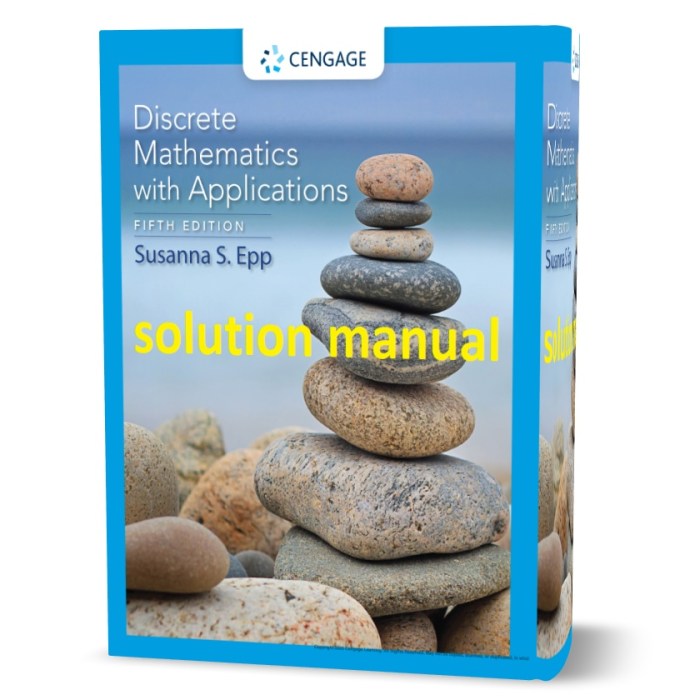Discrete mathematics with applications 4th edition by susanna s epp – Discrete Mathematics with Applications, 4th Edition by Susanna S. Epp, offers a comprehensive exploration into the captivating world of discrete mathematics. This esteemed text provides a solid foundation in the fundamental concepts and principles of this multifaceted field, equipping readers with the knowledge and skills necessary to tackle complex problems and drive innovation across various disciplines.
From the historical roots of discrete mathematics to its profound impact on modern technology, this book delves into the subject’s rich tapestry, illuminating its relevance and applications in computer science, artificial intelligence, cryptography, and beyond. With its engaging narrative and abundance of real-world examples, Discrete Mathematics with Applications, 4th Edition empowers readers to unlock the potential of discrete mathematics and harness its power to shape the future.
1. Introduction to Discrete Mathematics

Discrete mathematics deals with objects that can be counted or separated into distinct units. It encompasses the study of finite sets, logic, relations, functions, graphs, and number theory, providing a solid foundation for computer science, operations research, and other fields.
The origins of discrete mathematics can be traced back to ancient civilizations, with significant contributions from mathematicians such as Euclid, Archimedes, and Fibonacci. In modern times, discrete mathematics has become increasingly important due to its applications in computer science, cryptography, and network theory.
2. Logic and Proof Techniques
Logic is the study of reasoning and argumentation. Propositional logic deals with statements that can be either true or false, while predicate logic extends this to include variables and quantifiers. Proof techniques provide methods for establishing the validity of mathematical statements.
Proof Techniques
- Direct proof: Proving a statement by constructing a logical argument that shows its truth.
- Indirect proof: Proving a statement by assuming its negation and showing that this leads to a contradiction.
- Proof by contradiction: Proving a statement by assuming its negation and showing that this leads to a contradiction.
3. Set Theory and Combinatorics
Set theory deals with the study of sets, which are collections of distinct objects. Combinatorics deals with the counting and arrangement of objects.
Combinatorics
- Permutations: Counting the number of ways to arrange objects in a specific order.
- Combinations: Counting the number of ways to select objects without regard to order.
- Pigeonhole principle: If n pigeons are placed in m pigeonholes, with n > m, then at least one pigeonhole will contain more than one pigeon.
4. Relations and Functions

Relations are sets of ordered pairs, while functions are relations that assign a unique output to each input. Relations and functions are essential in computer science for representing data and modeling relationships.
Equivalence Relations
- Reflexivity: Each element is related to itself.
- Symmetry: If a is related to b, then b is related to a.
- Transitivity: If a is related to b and b is related to c, then a is related to c.
5. Number Theory and Cryptography
Number theory deals with the study of integers and their properties. Cryptography uses number theory to develop methods for secure communication.
Applications of Number Theory in Cryptography, Discrete mathematics with applications 4th edition by susanna s epp
- Public-key cryptography: Uses two different keys, one for encryption and one for decryption.
- Digital signatures: Uses number theory to create a unique digital signature for a message.
6. Graph Theory and Applications
Graph theory deals with the study of graphs, which are mathematical structures consisting of vertices and edges. Graphs are used to model a wide variety of real-world problems, such as networks, scheduling, and optimization.
Graph Algorithms
- Depth-first search: Traverses a graph by following a single path as far as possible before backtracking.
- Breadth-first search: Traverses a graph by visiting all vertices at a given level before moving to the next level.
- Dijkstra’s algorithm: Finds the shortest path between two vertices in a weighted graph.
7. Recurrence Relations and Generating Functions
Recurrence relations are equations that define a sequence of terms based on the previous terms. Generating functions are a powerful tool for solving recurrence relations.
Applications of Generating Functions
- Counting sequences: Generating functions can be used to count the number of sequences that satisfy certain conditions.
- Solving recurrence relations: Generating functions can be used to solve recurrence relations by converting them into algebraic equations.
8. Automata and Formal Languages
Automata are mathematical models of computation that can be used to recognize and generate languages. Formal languages are sets of strings that can be generated by a given grammar.
Chomsky Hierarchy of Formal Languages
- Type 0: Unrestricted grammars
- Type 1: Context-sensitive grammars
- Type 2: Context-free grammars
- Type 3: Regular grammars
Clarifying Questions: Discrete Mathematics With Applications 4th Edition By Susanna S Epp
What are the key features of Discrete Mathematics with Applications, 4th Edition?
Discrete Mathematics with Applications, 4th Edition offers a comprehensive and engaging exploration of discrete mathematics, featuring:
- Clear and concise explanations of fundamental concepts and principles
- Abundant real-world examples and applications across various fields
- Step-by-step demonstrations of proof techniques and problem-solving strategies
- Challenging exercises and thought-provoking questions to reinforce understanding
- Historical insights into the development of discrete mathematics
Who is the intended audience for this book?
Discrete Mathematics with Applications, 4th Edition is designed for students, researchers, and practitioners seeking a comprehensive understanding of discrete mathematics. It is suitable for undergraduate and graduate courses in discrete mathematics, computer science, mathematics, engineering, and related fields.
What are the prerequisites for studying Discrete Mathematics with Applications, 4th Edition?
A basic understanding of mathematics, including set theory, logic, and algebra, is recommended. Familiarity with basic programming concepts would also be beneficial.